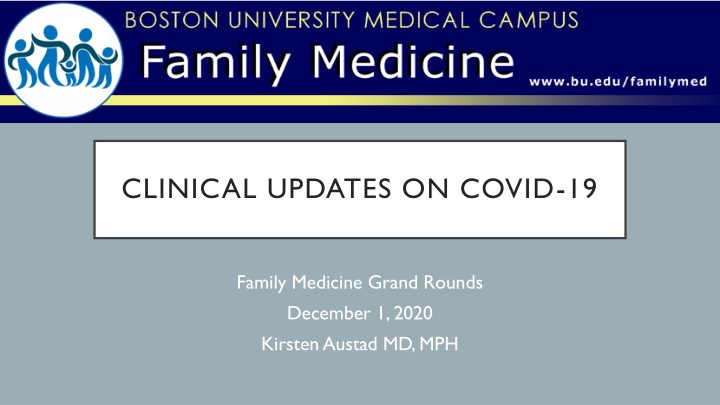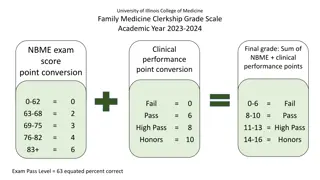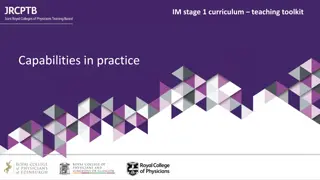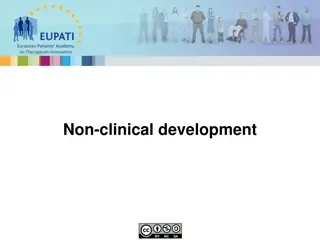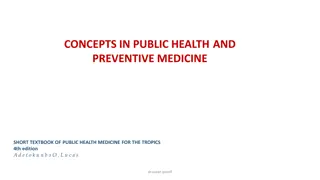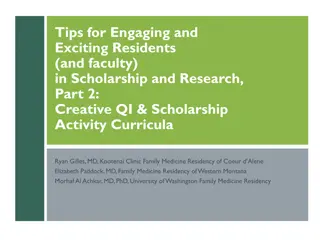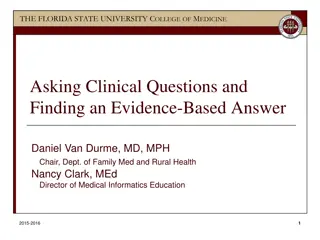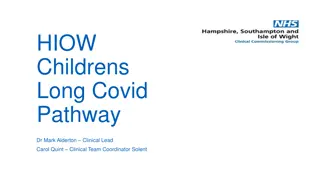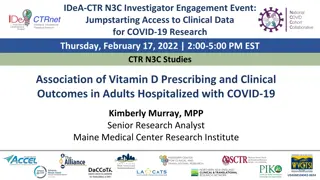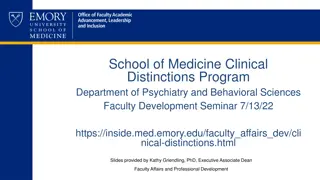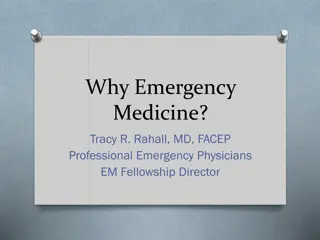Clinical Updates on COVID-19: Family Medicine Insights Dec 2020
This presentation covers updates on COVID-19 epidemiology, testing, risk factors for severe infection, differences from the spring surge, clinical symptoms, and more. Learn about current treatments, complications, and vaccine development. Explore factors contributing to lower mortality rates and increased infections among younger individuals. Gain insights into the challenges of testing accuracy, risk factors like blood type and pregnancy, and strategies for managing COVID-19 infections.
Download Presentation

Please find below an Image/Link to download the presentation.
The content on the website is provided AS IS for your information and personal use only. It may not be sold, licensed, or shared on other websites without obtaining consent from the author.If you encounter any issues during the download, it is possible that the publisher has removed the file from their server.
You are allowed to download the files provided on this website for personal or commercial use, subject to the condition that they are used lawfully. All files are the property of their respective owners.
The content on the website is provided AS IS for your information and personal use only. It may not be sold, licensed, or shared on other websites without obtaining consent from the author.
E N D
Presentation Transcript
CLINICAL UPDATES ON COVID-19 Family Medicine Grand Rounds December 1, 2020 Kirsten Austad MD, MPH
CONFLICT OF INTEREST I have no relevant disclosures DISCLAIMER A lot of what I told your earlier in 2020 is untrue
LEARNING GOALS 1 2 3 4 Update understanding of clinical presentation of COVID-19 Review the evidence for and against agents used to treat COVID-19 Highlight complications and long-term sequalae of COVID-19 infection Provide an overview of vaccines currently in development for COVID-19
EPIDEMIOLOGY March 17, 2020 November 25, 2020 https://coronavirus.jhu.edu/map.html
DIFFERENCES FROM SPRING SURGE Lower mortality rate Confirmed reasons: more infections are among younger people Speculated reasons Lower viral inoculates due to better masking Partial immunity Better treatments available (vs fewer harmful treatments?)
TESTING FOR COVID-19 NAAT tests for COVID-19 have estimated false negative rate 2-29%3 Factors that influence it include quality of specimen, IDSA recommends nasopharyngeal, mid-turbinate, or nasal specimens over oropharyngeal COVID-19 diagnostics in context. Weissleder R, Lee H, Ko J, Pittet MJ Sci Transl Med. 2020;12(546) Occurrence and Timing of Subsequent SARS-CoV-2 RT-PCR Positivity Among Initially Negative Patients. Long DR, Gombar S, Hogan CA, Greninger AL, O'Reilly-Shah V, Bryson-Cahn C, Stevens B, Rustagi A, Jerome KR, Kong CS, Zehnder J, Shah NH, Weiss NS, Pinsky BA, Sunshine J Clin Infect Dis. 2020 3Arevalo-Rodriguez I, Buitrago-Garcia D, Simancas-Racines D, et al. False-negative results of initial RT-PCR assays for covid-19: a systematic review. medRxiv
RISK FACTORS FOR SERIOUS COVID INFECTION Other Blood group: highest risk of infection in blood group A, lowest in blood group O Pregnancy: increased risk of ICU admission, intubation, ECMO, and death Non-white Socioeconomic disadvantage
ATYPICAL PRESENTATION Neurologic Encephalopathy, agitation/confusion Corticospinal tracts Motor/sensory deficits, ataxia Seizures Acute stroke Dermatologic Chilblains
WHO SHOULD BE ADMITTED? Working Draft of BMC ED Admission Guidelines Medical Any dyspnea* or RR > 30 Any pt with O2 sat < 94% on RA or PaO2/FiO2 < 300 mmHg Clinical concern for risk of outpatient failure based on high-risk status Age > 65, serious CV disease, COPD or other pulmonary dz, DM, malignancy, BMI > 30, CKD, immunocompromised (solid organ transplant, recipient of immunosuppression, pregnancy, sickle cell disease), asthma (moderate to severe), CVA Social Have reliable phone number and follow-up Ability to follow self-isolation recommendations No household members who are pregnant, immunosuppressed, or have hx ESRD
TREATMENT: IDSA GUIDELINES Hydroxychloroquine (+/- azithromycin): NOT recommended Remdesivir: recommended only for severe disease (hospitalized patients with saturation < 94% on RA) Limitations: use with caution in GFR < 30 (removed by dialysis) Side effects: nausea/vomiting, elevation AST/ALT Dexamethasone: recommended only for severe disease (hospitalized patients with saturation < 94% on RA) Biologics: research purposes only IL-1 inhibitors (Anakinra) IL-6 inhibitors (tocilizumab, sarilumab) Jak-kinase inhibtors (baricitinib) Spike protein neutralizing antibodies (bamlanivimab) Convalescent plasma: research purposes only Source: https://www.idsociety.org/practice-guideline/covid-19-guideline-treatment-and-management/#toc-10
BARICITINIB ACTT-2: double-blind placebo controlled RCT for use of baricitinib in combination with remdesivir Reduced recovery time by 1 day within 29 day after initiating treatmnted (vs placebo) 7 days vs 8 days, p=0.047 (CI 1.00-1.1) Mortality rate by date 29: 4.7% intervention group vs 7.1% placebo group (non-significant) Baricitinib increases risk of thrombosis FDA approved for Emergency Use Authorization on 11/19/2020 Not currently recommended given relative safety of dexamethasone
TOCILIZUMAB https://www.idsociety.org/practice-guideline/covid-19-guideline-treatment-and-management
https://www.covid19treatmentguidelines.nih.gov/therapeutic-management/https://www.covid19treatmentguidelines.nih.gov/therapeutic-management/
HYPERCOAGULABILITY Elevated D-dimer correlates with risk of VTE and mortality Antiphospholipids may be present Cumulative incidence of thrombosis 31% (Klok et al 2020 Thrombosis Research)
POST-COVID SYNDROME About 10% of patients have persistent symptoms post-COVID infection Most common symptoms include fatigue, cough, dyspnea, arthralgias, chest pain More common in older patients and those with multiple medical comorbidities 57% of patients with > 3 chronic conditions reported they had not yet returned to baseline health status (median interview time 16 days post-confirmed positive)
THANK YOU All of you for helping BMC care for COVID and non-COVID patients alike DFM leadership Hospitalist Medicine Group, General Internal Medicine, and residents/fellows who have joined inpatient COVID teams
